FWS Proposes to List Gunnison Sage-Grouse as Endangered
 |
| Gunnison Sage-Grouse by Noppadol Paothong |
(Washington, D.C., January 15, 2013) The U.S. Fish and Wildlife Service (FWS) has proposed to list the Gunnison Sage-Grouse as endangered under the Endangered Species Act and designate 1.7 million acres of critical habitat in an effort to halt the long term population decline of the iconic western bird.
FWS says that that the principal threat to Gunnison Sage-Grouse is habitat loss, degradation, and fragmentation due to residential, urban, and commercial development and associated infrastructure such as roads and power lines. Some estimates suggest that over 90 percent of the bird’s historic habitat has been lost.
“Adding the Gunnison Sage-Grouse to the list of endangered species marks an important turning point for this amazing bird,” said Steve Holmer, Senior Policy Advisor at American Bird Conservancy. “With ongoing development pressure and a growing human population, firm protection measures for its remaining habitat are urgently needed.”
On
The U.S. District Court for the District of Columbia approved a settlement agreement with WildEarth Guardians and Center for Biological Diversity laying out a multi-year listing work plan for addressing candidate species, including the Gunnison Sage-Grouse. As part of this agreement, the Service agreed to publish a proposed rule to list Gunnison Sage-Grouse and designate critical habitat.
Gunnison Sage-Grouse currently occur in seven widely scattered and isolated populations in Colorado and Utah, occupying 1,511 square miles. The seven populations are Gunnison Basin, San Miguel Basin, Monticello–Dove Creek, Piñon Mesa, Crawford, Cerro Summit–Cimarron–Sims Mesa, and Poncha Pass. Recent population estimates among these seven population trends over the last 12 years indicate that six of the populations are in decline. The largest population, the Gunnison Basin population, while showing variation over the years, has been relatively stable through the period.
“Sagebrush habitats within the range of Gunnison Sage-Grouse are becoming increasingly fragmented as a result of various changes in land uses and the expansion in the density and distribution of invasive plant species,” said Holmer. “A variety of human developments including roads, energy development, residential development, and other factors that cause habitat fragmentation have contributed to or been associated with Gunnison and Greater Sage-Grouse extirpation.”
The human population in all counties within the range of Gunnison Sage-Grouse averaged a 70 percent increase since1980. The projected human population for the year 2050 for the Gunnison River basin (an area that encompasses the majority of the current range of Gunnison Sage-Grouse) is expected to be 2.3 times greater than the 2005 population. The population of Gunnison County, an area that supports more than 80 percent of all Gunnison Sage-Grouse, is predicted to more than double to approximately 31,100 residents by 2050.
These population increases typically bring increases in power line installation which can cause a significant increase in grouse predation from Golden Eagles, who use the power lines as perches to attack from. In one study, Golden Eagle predation on sage-grouse on leks increased from 26 to73 percent of the total predation after completion of a transmission line within 220 yards of an active sage-grouse lek in northeastern Utah. The lek was eventually abandoned.
Livestock may compete directly with sage-grouse for rangeland resources. Grazing by livestock could reduce the suitability of breeding and brood-rearing habitat, negatively affecting sage-grouse populations. At least 87 percent of occupied Gunnison Sage-Grouse habitat on Federal lands is currently grazed by domestic livestock. Livestock can trample sage-grouse nests and nesting habitat. Although the effect of trampling at a population level is unknown, outright nest destruction has been documented, and the presence of livestock can cause sage-grouse to abandon their nests.


















































